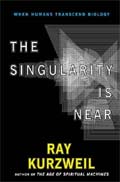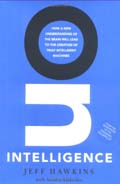Here we have a great variety of books, from a vision of the future to what teenagers are thinking about sex. All have merit for people who are concerned about what the future holds for them and their families. All of the reviewed can be found in Amazon’s Web site. — ED
Click on book title or image for more reviews or purchasing information.
 The Singularity Is Near : When Humans Transcend Biology –
The Singularity Is Near : When Humans Transcend Biology –
by Ray Kurzweil
From Booklist
Continuing the themes of The Age of Spiritual Machines (1999), Kurzweil further expounds his conviction that the human being will be succeeded by a superintelligent entity that is partly biological, partly computerized. Welcoming this prospect, and regarding it as inevitable, Kurzweil plunges into contemporary technological arenas, particularly genetics, nanotechnology, and robotics. Citing examples from medical devices to military weapons in which human control is increasingly detached from the autonomy of machines, Kurzweil stresses that trends are accelerating in terms of miniaturization and computational power. Eventually, smallness and speed reach a point of development, a “singularity,” with implications Kurzweil says even he cannot imagine. Disinclined to categorize his views as dystopian or utopian, the author recognizes that his vision is profoundly threatening to concepts of human nature and individuality. A closing section on philosophy and ethics accordingly addresses objections to his optimistic predictions. An involved presentation, this is best for readers of the wide-angle, journalistic treatment Radical Evolution (2005), by Joel Garreau. Gilbert Taylor
Copyright © American Library Association. All rights reserved
 On Intelligence by Jeff Hawkins
On Intelligence by Jeff Hawkins
From Publishers Weekly
Hawkins designed the technical innovations that make handheld computers like the Palm Pilot ubiquitous. But he also has a lifelong passion for the mysteries of the brain, and he’s convinced that artificial intelligence theorists are misguided in focusing on the limits of computational power rather than on the nature of human thought. He “pops the hood” of the neocortex and carefully articulates a theory of consciousness and intelligence that offers radical options for future researchers. “[The ability to make predictions about the future… is the crux of intelligence,” he argues. The predictions are based on accumulated memories, and Hawkins suggests that humanoid robotics, the attempt to build robots with humanlike bodies, will create machines that are more expensive and impractical than machines reproducing genuinely human-level processes such as complex-pattern analysis, which can be applied to speech recognition, weather analysis and smart cars. Hawkins presents his ideas, with help from New York Times science writer Blakeslee, in chatty, easy-to-grasp language that still respects the brain’s technical complexity. He fully anticipates-even welcomes-the controversy he may provoke within the scientific community and admits that he might be wrong, even as he offers a checklist of potential discoveries that could prove him right. His engaging speculations are sure to win fans of authors like Steven Johnson and Daniel Dennett.
Copyright © Reed Business Information, a division of Reed Elsevier Inc. All rights reserved
 The Real Truth About Teens and Sex: by Sabrina Weill
The Real Truth About Teens and Sex: by Sabrina Weill
From Publishers Weekly
Hooking up: two teenagers meeting at the mall, or having drunken sex at a party shortly after meeting for the first time- Both, actually. And the central activity at a “chicken party” couldn’t be performed by anything with a beak. Weill, former editor of Seventeen, seeks to demystify these and other steamy topics in her third book on teens and sex. Writing for parents and educators, Weill preaches communication and education as keys to staving off unwanted pregnancies, health problems and other pitfalls of becoming prematurely sexually active. Her advice is practical, but the suggested dialogues she provides can come off as Pollyanna. (“I want you to promise me you won’t fool around with someone when either you or the guy or the girl have been drinking.”) Peppered with survey and sexual health factoids-42 percent of 15-year-olds know someone who’s had sex at home while their parents were in the house, and 29 percent of 12 – 17-year-olds think that someone who does everything but have sex is not a virgin-parents looking for insight into what goes on in their kids’ beds can find plenty of answers here, though some may be hesitant to take a magazine editor’s advice.
Copyright © Reed Business Information, a division of Reed Elsevier Inc. All rights reserved.
 The Shame of the Nation : The Restoration of Apartheid Schooling in America by Jonathan Kozol
The Shame of the Nation : The Restoration of Apartheid Schooling in America by Jonathan Kozol
From Publishers Weekly
Public school resegregation is a “national horror hidden in plain view,” writes former educator turned public education activist Kozol (Savage Inequalities, Amazing Grace). Kozol visited 60 schools in 11 states over a five-year period and finds, despite the promise of Brown v. Board of Education, many schools serving black and Hispanic children are spiraling backward to the pre-Brown era. These schools lack the basics: clean classrooms, hallways and restrooms; up-to-date books in good condition; and appropriate laboratory supplies. Teachers and administrators eschew creative coursework for rote learning to meet testing and accountability mandates, thereby “embracing a pedagogy of direct command and absolute control” usually found in “penal institutions and drug rehabilitation programs.”
As always, Kozol presents sharp and poignant portraits of the indignities vulnerable individuals endure. “You have all the things and we do not have all the things,” one eight-year-old Bronx boy wrote the author. In another revealing exchange, a cynical high school student tells his classmate, a young woman with college ambitions who was forced into hair braiding and sewing classes, “You’re ghetto-so you sew.” Kozol discovers widespread acceptance for the notion that “schools in ghettoized communities must settle for a different set of academic and career goals” than schools serving middle-and upper-class children. Kozol tempers this gloom with hopeful interactions between energetic teachers and receptive children in schools where all is not lost. But these “treasured places” don’t hide the fact, Kozol argues, that school segregation is still the rule for poor minorities, or that Kozol, and the like-minded politicians, educators and advocates he seeks out, believe a new civil rights movement will be necessary to eradicate it.
Copyright © Reed Business Information, a division of Reed Elsevier Inc. All rights reserved.
